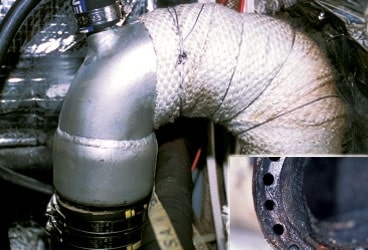
Several devices allow sea-water to be safely and effectively pumped into the exhaust system to cool and quiet it without causing damage to the engine. Two of these items are the injected elbow and the vented loop, the latter also known as a siphon break. When these work correctly, they protect your engine from flooding by seawater.
The injected elbow may assume many forms, but nearly all share a few traits. Injected elbows are typically 90-degree and sometimes 45-degree pieces of cast or welded pipe that are attached to the engine’s exhaust manifold. Injected elbows may be made using a variety of alloys, from simple iron and steel to exotic Inconel and cupronickel. The walls of the elbow are usually jacketed, which means they possess an inner and an outer layer, between which seawater is pumped; inner holes spray this water into the hot exhaust-gas stream, and herein lies the problem.
In some elbow designs, the jacket may hold water at all times, even when the engine isn’t running. These are known as jacketed risers, and they’re often used to raise the injection point above the vessel’s sailing or dynamic waterline. If the outer wall of the jacket develops a leak, seawater spills out, often onto the engine, starter, or transmission, where it may lead to corrosion and other problems. If, however, the inner jacket should develop a leak, the consequences can be more dire. Seawater may leak back into the engine through open exhaust valves, causing severe damage that’s frequently irreparable.
Even if the injected elbow isn’t of the jacketed-riser variety, it can still wreak havoc with your engine and engine compartment if it develops a leak. Under some circumstances, water may still leak back into the engine or leak out of the riser while the vessel is under power, spewing a mixture of exhaust gases and seawater mist around the engine compartment. This caustic cocktail will cause rapid corrosion and, if it’s drawn into the air intake, will do damage to the engine’s internal components. Inspect your injected elbow for even the slightest signs of leakage or corrosion and quickly replace it if these are in evidence.
The vented loop or siphon break, located in the cooling hose above the waterline, wages the other half of your engine’s battle against seawater ingress. Because the engine and some of the exhaust components are often located below the waterline, a functioning vented loop must be employed when the engine is idle to keep water from siphoning into the exhaust system, where it can eventually back up into the exhaust manifold and engine.
The cause of most vented-loop failures is salt and soot encrustation. The vent should be cleaned and/or replaced at least once a year or every 100 hours. Also, make sure your vented loop is located well above the heeled waterline.
Steve D’Antonio is a regular Cruising World contributor who offers services for vessel owners, boatbuilders, and others in the marine industry through Steve D’Antonio Marine Consulting (www.stevedmarineconsulting.com).








